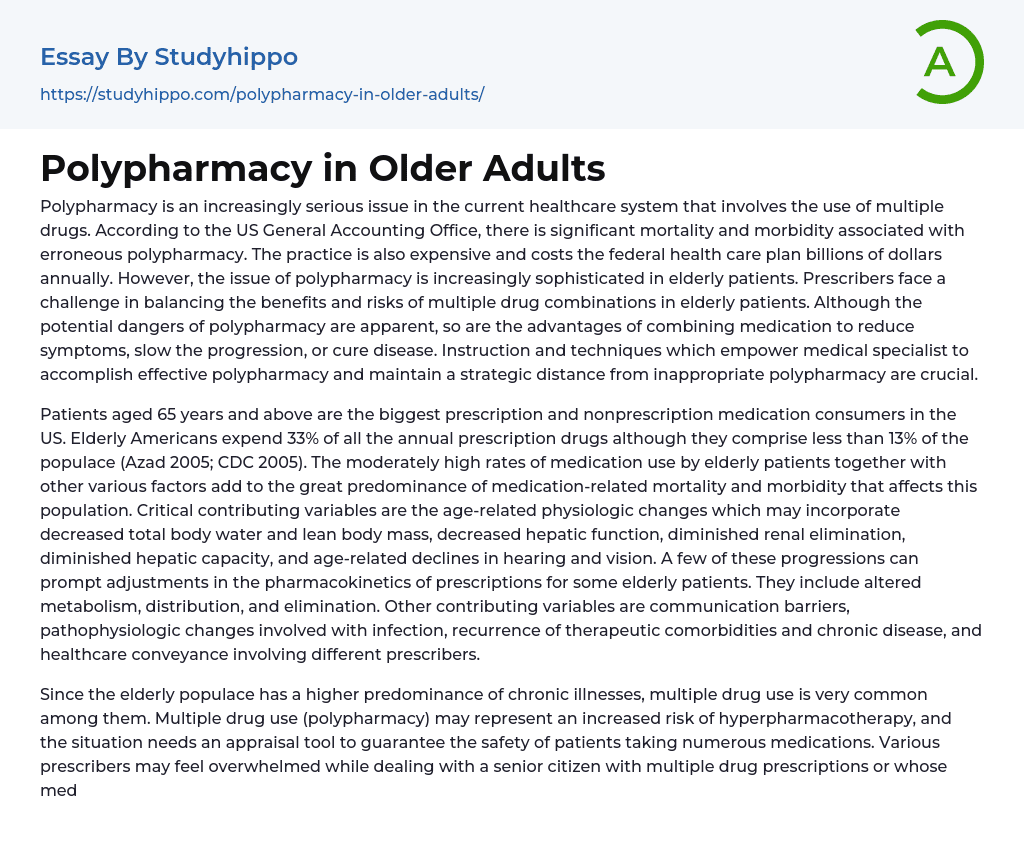Polypharmacy, or the use of multiple drugs, is a rising concern in today's healthcare system. The US General Accounting Office reports that this practice results in various deaths and illnesses, as well as imposing substantial expenses on the federal health care plan annually, amounting to billions of dollars.
The increasing concern over the complexity of polypharmacy in elderly patients requires prescribers to carefully weigh the benefits and drawbacks of administering multiple drugs. While there are evident risks, polypharmacy can also offer advantages such as alleviating symptoms, managing disease progression, and potentially even providing potential cures. To ensure effective polypharmacy without inappropriate drug combinations, medical specialists need proper guidance and techniques.
The elderly population in the US, which accounts for less than 13% of the total population, consumes a significant amount of prescription and nonprescription medication. In fact, individuals aged 65 years and abov
...e utilize 33% of all annual prescription drugs (Azad 2005; CDC 2005). This substantial medication usage among older Americans contributes to a notable prevalence of medication-related mortality and morbidity within this age group. Multiple factors contribute to this phenomenon, including physiological changes associated with aging such as decreased total body water and lean body mass, impaired hepatic function and renal elimination, reduced hepatic capacity, as well as declines in hearing and vision. These changes can impact the pharmacokinetics of medications for certain elderly patients by altering their metabolism, distribution, and elimination processes.
"Hyperpharmacotherapy" or inappropriate polypharmacy in older adults is influenced by several factors. These factors include difficulties in communication, changes in the body's functioning due to infection, recurrence of medical conditions and chronic diseases, and the involvement of multiple healthcare providers in prescribing medications. Olde
adults often have multiple chronic illnesses that require multiple medications, which increases their risk. To ensure patient safety while taking multiple drugs, a tool is needed. Healthcare providers can find it overwhelming to manage unpredictable medication schedules or numerous prescriptions for elderly individuals. Various clinical tools can be used to evaluate and support the examination of an individual patient's drug treatment plan.
An effective strategy to reduce excessive medication use in patients is careful monitoring and gradual reduction of specific medications. Prescribers should avoid making multiple changes to a treatment plan at once, as this can be challenging. Abruptly stopping drugs can cause hospitalization and worsen existing conditions. Instead, it is better to gradually taper off one medication while monitoring for withdrawal symptoms and worsening illness. Primary healthcare professionals, such as physician assistants, are well-placed to promote proper medication use in elderly patients and may have more time compared to their supervising physicians.
Extra time during a clinical interview can be used to conduct the drug survey process.
Conclusion
The population of senior citizens, also known as the elderly, is growing, leading to a higher occurrence of multiple and chronic diseases. Healthcare professionals must effectively manage medication for these conditions while avoiding potential risks such as incorrect dosage, interactions between drugs and diseases, interactions between drugs themselves, and adverse effects. The main objective in addressing inappropriate polypharmacy is to enhance patients' quality of life.
When discontinuing drugs linked to polypharmacy, it is crucial to assess them carefully. This helps prevent worsening the patient's condition and addresses inappropriate polypharmacy.
Reference
- Bushardt, K., Reamer L. (2008). Polypharmacy: Misleading, but manageable. Clinical Interventions In Aging, 3(2), 383. Retrieved from https://www.ncbi.nlm.nih.gov/pmc/articles/PMC2546482/
- Automotive essays
- Automotive Industry essays
- Commerce essays
- Construction essays
- E Commerce essays
- Grocery stores essays
- Paper Industry essays
- Pharmaceutical industry essays
- Pharmacy essays
- Polymers essays
- Real Estate essays
- Textile Industry essays
- My Favorite Place essays
- Overcoming Obstacles essays
- Taking Risks essays




